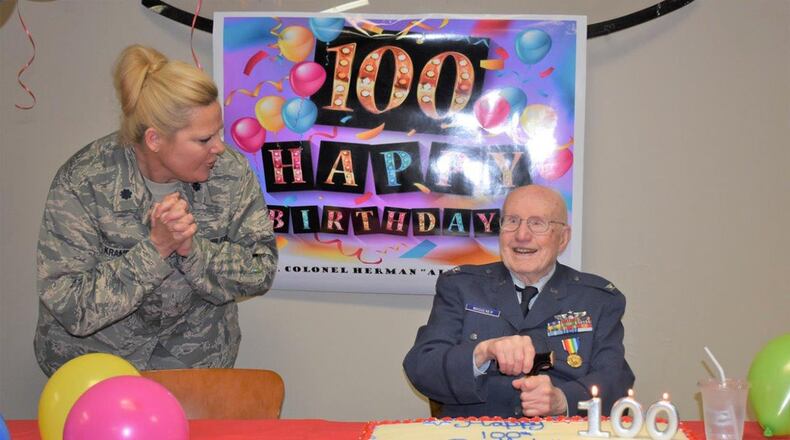Waggener said he was overwhelmed by the celebration.
“I never expected anything like that,” said Waggener. “I enjoyed saying hello to all those people in the dining room. They were all so nice, and the cake was good.”
Waggener also expressed his appreciation for everyone involved in putting the celebration together.
The celebration was spearheaded by Lt. Col. Karen Kramer, 88th Medical Group Public Health Flight commander.
Kramer said she remembered being impressed by the then 99-year-old Waggener when she met him at a 9/11 Patriot event in 2019, so she was excited to be asked to help him celebrate his 100th birthday.
“He is still a very valued part of our community,” said Kramer.
She worked with Kelly Lance from St. Leonard of CHI Living Communities to organize the celebration.
Kramer added that she thought it would be a great opportunity for young people and the Air Force’s next generation to be able to meet and show their appreciation for someone who was a retired Airman, WWII combat pilot and 100 years old.
“I wanted them to have the opportunity to be able to shake his hand, and that’s exactly what happened,” said Kramer.
In addition to the Airmen and his St. Leonard’s guests, Waggener’s two daughters were also able to attend the celebration.
“It just means everything,” said Pat Watts, Waggener’s oldest daughter who lives in Texas. “It’s just so special because dad gave his whole life to the Air Force … To be recognized, it’s just great.”
Sara-Jean Waggener-Snell, Waggener’s youngest daughter who lives in Ohio, added she thought Waggener felt honored to be recognized by the Airmen.
“I feel privileged to be his daughter,” she added. “I feel blessed to have a father that I have looked up to all my life because of his integrity, his intelligence, his sense of humor and his faith.”
Waggener was born Feb. 21, 1920. He joined the U.S. Army Air Corps in 1942. Waggener said he had one request.
“I asked to be a navigator because it was close to home, and I wanted to get married,” said Waggener.
Instead of being classified as a navigator, Waggener was classified as a pilot and sent to California for training.
Although Waggener said he was disappointed at first, he said things worked out. He was still able to marry “Floss” (Florence). The two had two children together and were married for 76 years before she passed away in 2019.
Waggener said the Air Force was good to him during his 26 years on active duty. During his time with the Air Force, he was assigned to several stateside locations, western Europe and Japan. He was also awarded several military decorations, including the Distinguished Flying Cross, Air Medals, Army and Air Force commendation medals and a D-Day medal.
Waggener earned his D-Day medal after he flew three missions over Normandy, France, June 6, 1944, in a P-38 Lightning aircraft for a total of nine hours.
In 1944, Waggener flew more than 50 combat missions over western Europe. He was a P-38 Lightning and P-51 Mustang pilot. Waggener reminisced about some of his flying experiences during a visit to the National Museum of the U.S. Air Force Jan. 24.
“It’s wonderful to be able to see the things that I flew and see the things that were so important to me in the past,” said Waggener. “You don’t get that opportunity very often.”
Along with his D-Day memories, Waggener also shared another flying experience with the group that accompanied him on the tour.
Waggener said he flew a P-51 to escort bombers to Munich, Germany. When he embarked on his return flight, the Germans had placed anti-aircraft guns along the coast of Europe.
“Just as I got over the French coast, one of their shells burst right under my airplane,” said Waggener.
“It turned me upside down, and I thought, ‘Oh boy, I got to get out of here,’” added Waggener. “I reached up to pull the latch to bail out, and it occurred to me that the engine was still running, so I turned the airplane over right-side up and flew home.”
Waggener said his plane had more than 40 small holes in the bottom of it from the attack, but it didn’t hit anything vital.
When asked which aircraft he preferred, Waggener replied the P-38 because it had two engines but could fly on one and because it was easy to fly since it didn’t have torque.
In addition to his flying missions, Waggener participated in various other missions throughout his career to include being part of the clean-up efforts for the Island of Iwo Jima in Japan after WWII.
Waggener spent his military career as a fighter pilot and procurement officer before retiring. He said he and his wife looked along the Gulf Coast for a place to settle, but ended up staying in the area because it was a nice place, and he was offered a position at Wright State University. He worked at WSU for 20 years before retiring. He still resides in the area.
“God has been real good to me, and here I am almost a hundred and still kicking; so I feel very fortunate. It’s been a good life,” said Waggener.
About the Author
